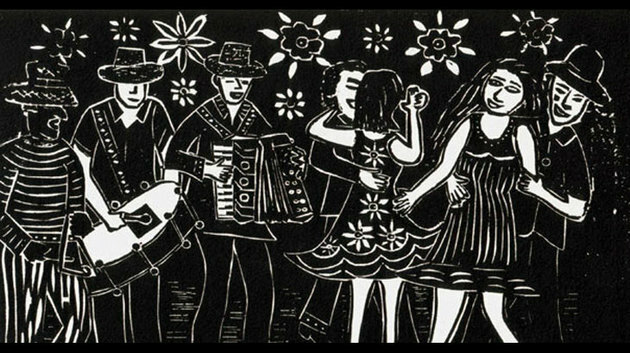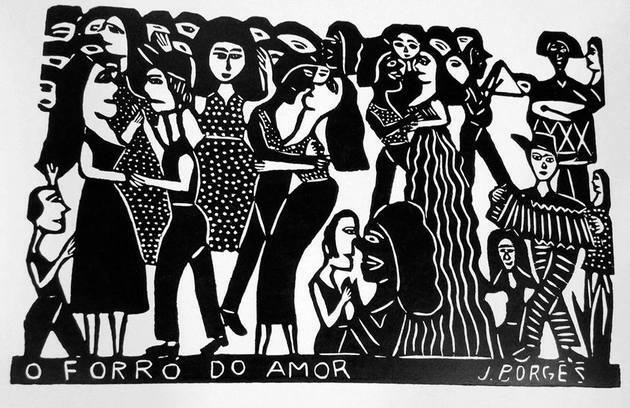Forró is a genuinely northeastern artistic expression. As a form of broad cultural manifestation, the term lining it has different meanings and can serve both to designate the musical rhythm, the style of dance and even the festivity in which it takes place.
How did forró come about?
Its origin is related to popular dances that were held at the end of the 19th century and were called "forrobodó", "forrobodança" or "forrobodão".
At that time, it was necessary to wet the floor of the place where these parties took place, as they were made of "hard floors", that is, there was no coating, only earth.
People used to dance by dragging their feet in order to prevent the dust from rising, hence the term scrape or drag.

Similarities were also found between this style of dance and the toré - Indigenous celebration where, at a given ritualistic moment, individuals drag their feet on the ground.
There is also a certain influence of Dutch and Portuguese rhythms, in addition to European ballroom dancing.
Origin of the name forró
The name forró suggests some hypotheses. Historian and folklorist Câmara Cascudo suggests that the most likely term is a derivation of the term "forrobodó".
This term, in turn, is a Galician-Portuguese variant of the old word forbodó, originated from the French word faux-bourdon, which can mean "disentanglement".
Another assumption - without historical proof - is that such a name would have been created from an English expression.
According to this theory, the British engineers who settled in the Pernambuco region during the installation of the railway great western, used to promote parties for illustrious figures.
However, at certain times, such events were open to the public and included in their invitations the term go all, which means "for all" in Portuguese. The local people then began to pronounce "forró".

But it was only in 1950 that the name "forró" was actually used. Because, a year earlier, singer and composer Luiz Gonzaga recorded the song "Forró by Mané Vito", produced together with Zé Dantas. In 1958, another song by the musician called "Forró in the Dark", was also very successful.
Despite the popularity achieved with the successes of this music icon, what really spread the Brazil's style was the Northeastern migration to other states in the country, especially in the 1960s and 1970.
Currently, forró is appreciated throughout Brazil and celebrated on December 13, the birth date of accordion player Luiz Gonzaga.
Forró as a musical genre
This musical style is popularly associated with other genres: o xote, O xaxado it's the baião. In them, the instrumental base used is the accordion, the triangle and the bass drum.
It is also called lining traditional or lining saw foot and its main representatives are Luiz Gonzada, Jackson do Pandeiro, Dominguinhos and Sivuca.

From the 80s onwards, the forró underwent some modifications. At that time, drums, guitar and electric bass were also introduced.
In the 1990s, other elements were incorporated by some bands, such as the keyboard and the sax, and the bass drum was removed. This subgenre is now called electronic forró or stylized and was criticized for transforming the traditional forró into a superficial product of cultural industry.
In the 2000s, this type of music got a new facelift and emerged in the form of university forró, which added some instrumental changes to the original style.
Forró as a dance

Forró is danced in pairs in a closed hug position, with the partners facing each other, using full or partial body contact.
Depending on the style of music played - baião, xote, xaxado, university forró or electronica - the way of dancing is also altered.
The main destinations for those who enjoy dancing forró are: Itaúnas (ES), Caruaru (PE) and Campina Grande (PB).
Are you interested in knowing more about Brazilian dances? Be sure to read the articles below.
- folk dances in Brazil
- Carimbó: everything about the typical dance of Pará
- Quadrilha: origin, dance, music and characteristics
- Historia do Sertanejo: the music of our sertão
Main representatives of forró
- Luiz Gonzaga
- Carmelia Alves
- little sundays
- Northeastern Trio
- Jackson do Pandeiro
- Sivuca
- Alceu Valença
- Elba Ramalho
- Geraldo Azevedo
- talkative
- Rastape
- Forroçacan
- Mastruck with milk
- Black panties
- Frank Aguiar
- Aviões do Forró



